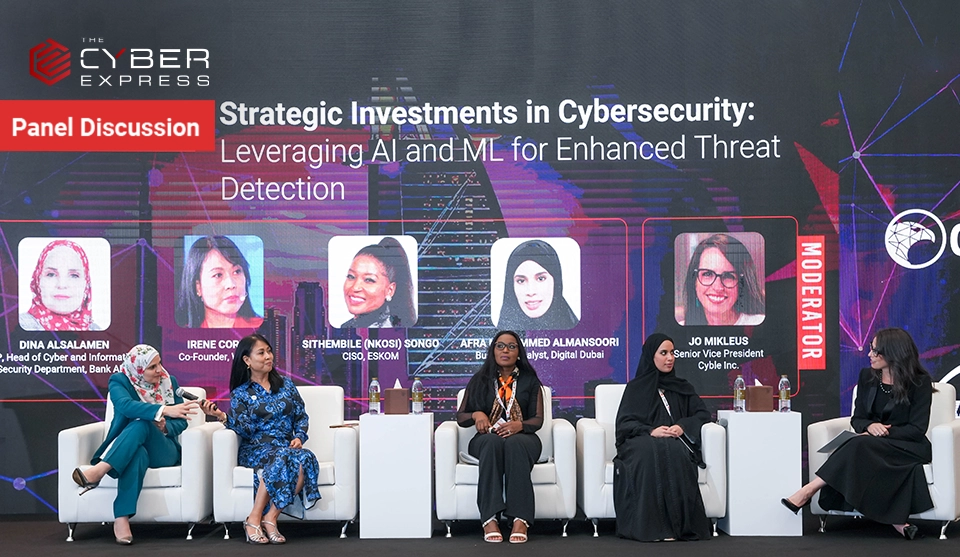The 2024 World CyberCon META Edition, a resounding success held at Al Habtoor Palace in Dubai, featured a prominent all-women panel discussion titled “Strategic Investments in Cybersecurity: Leveraging AI and ML for Enhanced Threat Detection.”
The panel, moderated by Jo Mikleus, Senior Vice President of Cyble Inc., featured contributions from an array of distinguished experts including Sithembile (Nkosi) Songo, Chief Information Security Officer at ESKOM; Dina Alsalamen, VP and Head of Cyber and Information Security at Bank ABC; Afra Mohammed Almansoori, Business Analyst at Digital Dubai; and Irene Corpuz, Co-Founder of Women in Cyber Security Middle East.
The session commenced with exploring how AI and machine learning (ML) are revolutionizing threat detection and response in cybersecurity.
Afra Mohammed Almansoori highlighted the transformative impact of these technologies: “AI isn’t just a substitute; it’s a game-changer for cybersecurity. By harnessing AI and machine learning, we enhance threat detection capabilities, allowing us to focus on strategic security initiatives.
World CyberCon META Edition: Transforming Threat Detection and Response
AI and ML are redefining the landscape of cybersecurity through various applications. Behavioral analytics, anomaly detection, and automated incident response are now integral to modern cybersecurity strategies. AI’s ability to analyze vast datasets and identify patterns that elude traditional methods enables organizations to preemptively address potential threats.
Irene Corpuz reinforced this notion, stating, “AI isn’t a replacement, it’s a force multiplier for cybersecurity. Leveraging AI and machine learning strengthens our defenses by automating threat detection, freeing us to focus on strategic security initiatives.”
(L-R: Sithembile (Nkosi) Songo – Chief Information Security Officer, ESKOM; Afra Mohammed Almansoori – Business Analyst, Digital Dubai; Dina Alsalamen, VP, Head of Cyber and Information Security Department, Bank ABC; Irene Corpuz – Co-Founder, Women in Cyber Security Middle East and Jo Mikleus – Senior Vice President, Cyble Inc.)Enhanced Accuracy and Speed
The panel discussed notable use cases where AI and ML have significantly enhanced the accuracy and speed of threat detection. In one instance, Bank ABC utilized AI-driven analytics to thwart a sophisticated phishing attack that traditional security measures failed to detect. By rapidly identifying and responding to anomalies, AI systems have proven to be a vital asset in the fight against cybercrime.
However, the integration of AI and ML into cybersecurity is not without challenges. The panel emphasized the importance of adopting applicable policies and standards to mitigate risks associated with these technologies. Regulatory frameworks must evolve to address issues such as data privacy, ethical use of AI, and the potential for AI-generated threats.
Integration with Existing Infrastructure
Integrating AI and ML capabilities with existing security infrastructure is another critical consideration. Organizations must ensure seamless integration to maximize the benefits of AI without disrupting their current operations. This involves upgrading legacy systems, training staff on new technologies, and continually assessing the performance of AI tools.
Best practices in reorienting strategic investments were also discussed. Companies are increasingly allocating resources towards AI capabilities to stay ahead of emerging threats. By investing in AI and ML, businesses can enhance their threat detection and response mechanisms, thereby safeguarding their digital assets more effectively.
Overcoming Implementation Challenges
The panel acknowledged the challenges and limitations of implementing AI and ML in cybersecurity, especially for small and medium-sized enterprises (SMEs). Resource constraints, lack of expertise, and integration issues are common hurdles. To overcome these challenges, organizations should consider collaborative approaches, such as partnering with cybersecurity firms and leveraging cloud-based AI solutions.
A key theme was the envisioned collaboration between humans and machines in cybersecurity operations. AI and ML technologies can augment the capabilities of human analysts by handling routine activities, thus allowing experts to focus on more strategic tasks. This symbiotic relationship enhances overall security posture and operational efficiency.
The reception from key stakeholders, including Boards, CEOs, and CFOs, was noted as increasingly positive. As cyber threats become more sophisticated, there is growing recognition of the need for enhanced cybersecurity measures. Business leaders are supporting CISOs in making the necessary investments to protect their organizations.
Delivering ROI
Finally, the panel discussed how to position business cases for AI in cybersecurity to deliver ROI. Demonstrating the tangible benefits of AI investments, such as reduced incident response times and minimized breach impact, is crucial for securing buy-in from stakeholders.
Jo Mikleus, Senior Vice President at Cyble Inc.Jo Mikleus summed up the session by stating, “It was a privilege to moderate the World CyberCon panel, discussing AI as a critical strategic investment for cybersecurity and managing threat intelligence.”
The Middle East’s Cybersecurity Imperative
As digitalization surges across the Middle East, the importance of strong cybersecurity measures cannot be overstated. The region’s rapid technological advancement necessitates a proactive approach to combat the escalating cyber threat landscape.
Leveraging AI and ML to complement traditional cybersecurity defenses is advantageous, but proactive measures are essential to mitigate AI-related risks. Shadow AI in the workplace is growing, with an alarming 156% increase in employees inputting sensitive corporate data into chatbots like ChatGPT and Gemini.
The World CyberCon Meta Edition 2024 underlines the critical role of AI and ML in modern cybersecurity strategies. As cyber threats continue to evolve, strategic investments in these technologies will be pivotal in safeguarding the digital future.
Source: Read More



